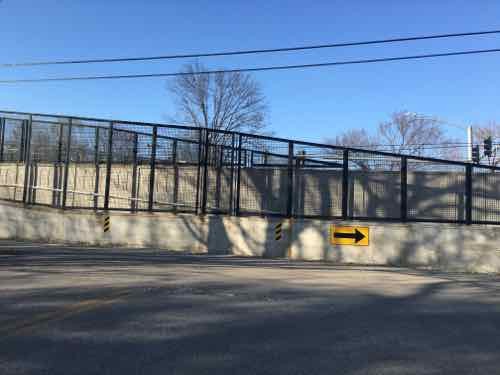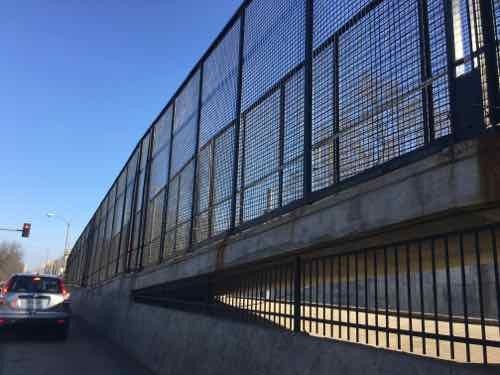Another Local Example of In-Street Light Rail
A couple of weeks ago I posted about a local example of light rail in center of a street, which was largely misunderstood. Objections to my Meramec Ave & Forest Park Parkway example included:
- Cars could never cross here
- Pedestrians have no reason to cross here
- Several cities have light rail systems without concrete walls, have pedestrian crossings
True, true, and true. No argument. My point was many existing cross streets would no longer be able to cross streets like Natural Bridge or Jefferson if we built light rail in the right-of-way. Places to cross by car, bike, or foot would be limited.
Some of the examples people mentioned included Minneapolis and Houston. I have no personal experience with either so I turned to the internet.
Houston’s original Red Line, opened in 2004, had few obstacles. The tracks were in the street with very little dividing it from traffic (example). Similar for their 2013 Red Line extension (example). The Green & Purple lines, opened in May 2015, are different. The Purple line has fences & barriers (example) but does provide pedestrian crossings between stations (example). Houston usually has 3-6 accidents per month, but had 17 in July.
Besides accidents, these can be slow. From 2014:
Residents of the Twin Cities greeted the opening of the new Green Line light rail link last month with joy and excitement, finally able to take advantage of a train connection between downtown Minneapolis and St. Paul. The 11-mile rail line runs through a relatively densely populated area, serves two business districts, and travels through the heart of a university.
It’s also alarmingly slow. Green Line trains are taking up to an hour to complete their journeys, and even optimistic schedules released by the local transit agency put running times at 48 minutes, or less than 14 mph on average.
Of course, the Twin Cities are hardly alone in their predicament. Recent transit lines elsewhere in the country feature similarly leisurely travel times. The new Houston North Line, for example, is averaging 17 mph. Los Angeles’ Expo Line is slightly quicker at 18 mph. Bus rapid transit and streetcar projects popping up virtually everywhere are often significantly slower. Only the Washington, D.C. Metro Silver Line, which will extend that region’s subway deep into the Virginia suburbs, will speed commuters along at an average of 32 mph. It will do so while only stopping at 5 stations, all of which will be located in the middle of expressways.
Our MetroLink, which operates in exclusive right-of-way, has an average speed of 24,7mph, according to Wikipedia. How does Metro achieve higher speeds? Less conflict points mean the vehicles can get to higher speeds between stations. Which brings me to another local example of how Metro builds light rail to reduce conflicts/accidents. Forest Park Parkway & Des Peres Ave., prior to the Blue Line, was as signalized intersection allowing cars, bikes, and pedestrians to cross the busy roadway.
The intersection is still signalized — and cars coming from the North can still cross here, as can pedestrians & cyclists. It’s roughly halfway between the Skinker & Forest Park stations — a mile apart.


Anyone who thinks Metro St. Louis will build an in-street light rail system — operated at expected light rail speeds — with easy pedestrian crossings between stations is naive. It’s not going to happen — and it shouldn’t. St. Louis has enough pedestrian deaths as it is!
I think we should improve North-South public transit in the region, through the city. I’m just looking at how Metro builds light rail and thinking it isn’t what people want.
— Steve Patterson
Once again, St Louis does NOT have any local examples of light rail that are even remotely like what is currently proposed for Natural Bridge and Jefferson. I do NOT consider myself naïve about the issue.
And once again these are the closest local examples we have for me to illustrate what we’ll most likely get between stations on Natural Bridge & Jefferson. They’re not exactly the same, but close.
Everyone is caught up in the pretty artist renderings of Kingshighway & Cherokee stations from July 2013 — not thinking critically about the rest and what it’ll do to the street grid.
Why are we discussing something that isn’t going to happen in our lifetimes? Might as well moot a Mars colony.
Both the city & county have growing piles from the transit sales tax earmarked for transit infrastructure. Used as a local match these funds could be used to get federal funds to cover the bulk of costs. St. Louis County is looking at projects within the county.
Something will happen…if we can agree on what.
Pretty much any transit vehicle can operate at higher (freeway) speeds or at slower (city street) speeds. It’s the operating envelope, the specific environment, that determines operating speeds, NOT the type of vehicle! I agree with both Herbie and Jason, there are way bigger issues than why Forest Park Parkway, both before Metrolink and after, was not, and remains, not very pedestrian friendly. The only reason local non-transit wonks continue to focus on light rail for the Northside-Southside “solution” is because it’s the only non-bus alternative many of them are familiar with. Once the Delmar streetcar starts operating, locals will have another non-bus transit alternative to evaluate, just like people are becoming familiar with longer, articulated buses along Grand. Finally, even though “both the city and the county have growing piles from the transit sales tax earmarked for transit infrastructure”, I wouldn’t count on the “federal funds to coover the bulk of the costs”. What used to be a 10% (local) / 90% (federal) split is, now, much closer to 50 / 50, and that is skewed heavily towards bus rapid transt (BRT) and not rail projects: https://www.federalregister.gov/articles/2016/02/16/2016-02821/notice-of-fta-transit-program-changes-authorized-funding-levels-and-implementation-of-federal-public . . and http://www.gao.gov/assets/600/592973.pdf . . and http://www.thetransportpolitic.com/2010/05/19/u-s-fta-rogoff-paints-grim-picture-of-nations-transit-priorities/ . . and http://www.mapc.org/sites/default/files/BRTvsLRT.pdf
And (given that we’re stuck with a republican congress for the foreseeable future) federal funds are likely to become ever scarcer. Also: Stenger has been very clear he’ll only support transit projects that are entirely within the county.
Seriously. We’ll be dead before St. Louis gets more rail. Our kids might be dead.